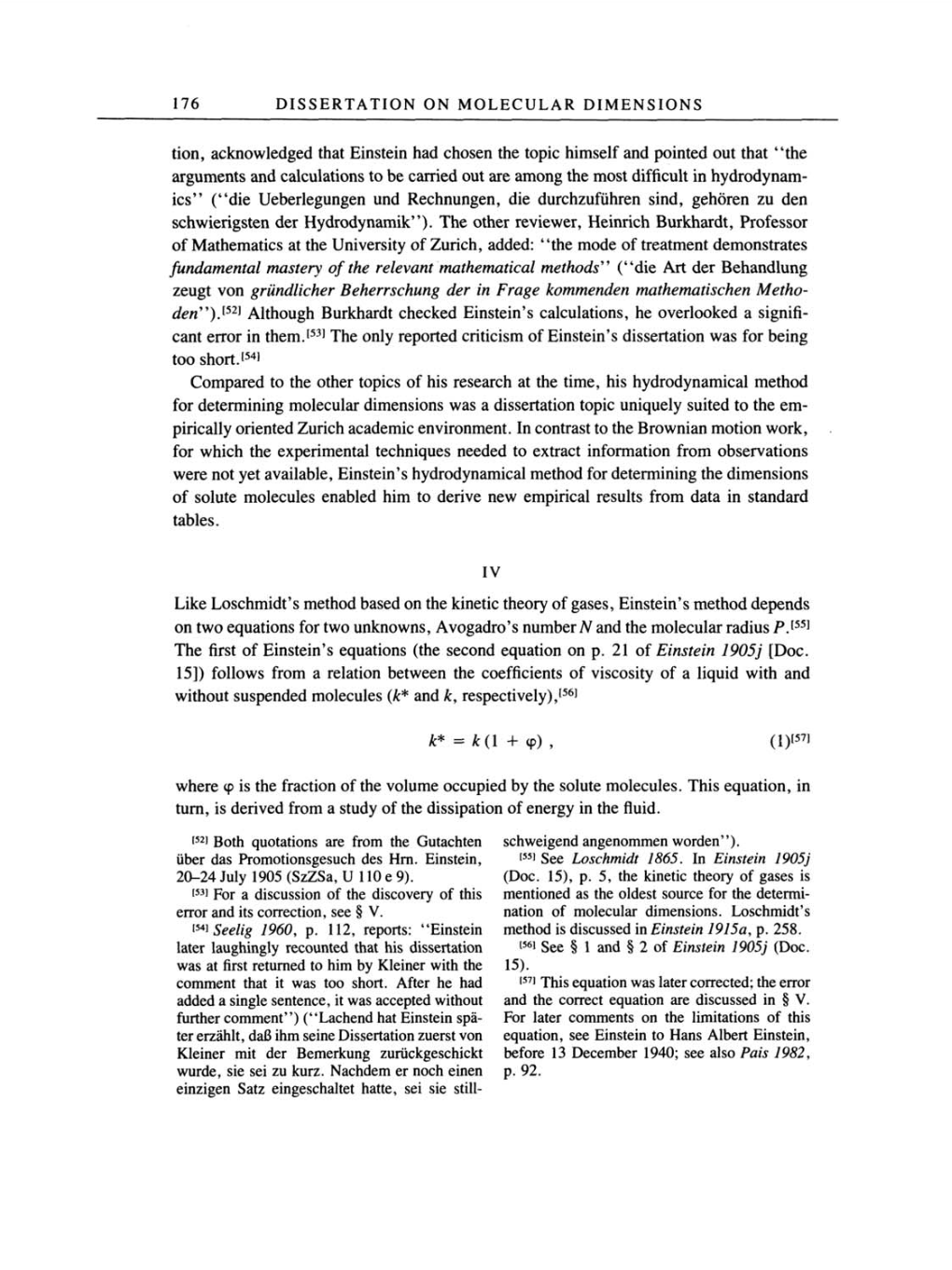176 DISSERTATION ON
MOLECULAR
DIMENSIONS
tion, acknowledged
that Einstein had chosen the
topic
himself and
pointed
out that
"the
arguments
and calculations
to be carried out
are
among
the most difficult in
hydrodynam-
ics"
("die
Ueberlegungen
und
Rechnungen,
die durchzuführen
sind,
gehören zu
den
schwierigsten
der
Hydrodynamik").
The other
reviewer,
Heinrich Burkhardt,
Professor
of
Mathematics at the
University
of
Zurich,
added:
"the
mode
of
treatment
demonstrates
fundamental
mastery
of
the
relevant mathematical methods"
("die
Art der
Behandlung
zeugt von
gründlicher Beherrschung
der
in Frage
kommenden mathematischen Metho-
den").[52] Although
Burkhardt checked
Einstein's
calculations,
he overlooked
a signifi-
cant
error
in
them.[53]
The
only
reported
criticism
of Einstein's
dissertation
was
for
being
too
short.[54]
Compared
to the other
topics
of
his research at the
time,
his
hydrodynamical
method
for
determining
molecular dimensions
was a
dissertation
topic uniquely
suited to the
em-
pirically
oriented Zurich academic environment.
In
contrast to
the
Brownian motion work,
for which the
experimental
techniques
needed to extract information from
observations
were
not
yet
available,
Einstein's
hydrodynamical
method for
determining
the
dimensions
of
solute molecules
enabled him
to
derive
new empirical
results from data in standard
tables.
IV
Like
Loschmidt's
method based
on
the kinetic
theory
of
gases,
Einstein's method
depends
on
two
equations
for two
unknowns, Avogadro's
number N and the
molecular
radius
P.[55]
The first
of Einstein's
equations
(the
second
equation on p.
21
of Einstein
1905j [Doc.
15])
follows from
a
relation between the coefficients
of
viscosity
of
a liquid
with and
without
suspended
molecules
(k*
and
k,
respectively),[56]
k*
=
k(l
+
9)
,
(l)[57]
where
(p
is
the fraction
of
the volume
occupied by
the solute molecules. This
equation,
in
turn, is
derived from
a study
of
the
dissipation
of
energy
in
the fluid.
[52]
Both
quotations
are
from
the Gutachten
über
das
Promotionsgesuch
des Hrn.
Einstein,
20-24
July
1905
(SzZSa,
U 110
e 9).
[53]
For
a
discussion
of
the
discovery
of
this
error
and
its
correction,
see
§
V.
[54] Seelig 1960,
p.
112, reports:
"Einstein
later
laughingly
recounted that his dissertation
was
at
first returned to him
by
Kleiner with
the
comment that it
was
too
short. After he had
added
a
single
sentence,
it
was
accepted
without
further comment") ("Lachend
hat Einstein
spä-
ter
erzählt,
daß ihm seine Dissertation zuerst
von
Kleiner mit der
Bemerkung zurückgeschickt
wurde,
sie sei
zu
kurz. Nachdem
er
noch
einen
einzigen
Satz
eingeschaltet hatte,
sei sie still-
schweigend angenommen
worden").
[55]
See Loschmidt 1865. In Einstein
1905j
(Doc. 15),
p.
5,
the kinetic
theory
of
gases
is
mentioned
as
the oldest
source
for the determi-
nation
of
molecular dimensions.
Loschmidt's
method
is
discussed in Einstein
1915a,
p.
258.
[56]
See
§
1
and
§
2
of
Einstein
1905j
(Doc.
15).
[57]
This
equation was
later
corrected;
the
error
and the
correct
equation are
discussed in
§
V.
For
later
comments
on
the limitations
of
this
equation,
see
Einstein
to
Hans Albert
Einstein,
before 13
December
1940;
see
also
Pais
1982,
p.
92.
